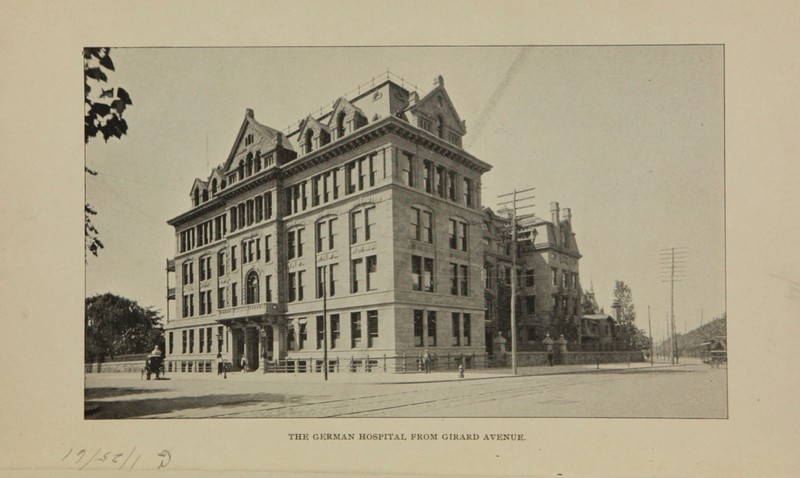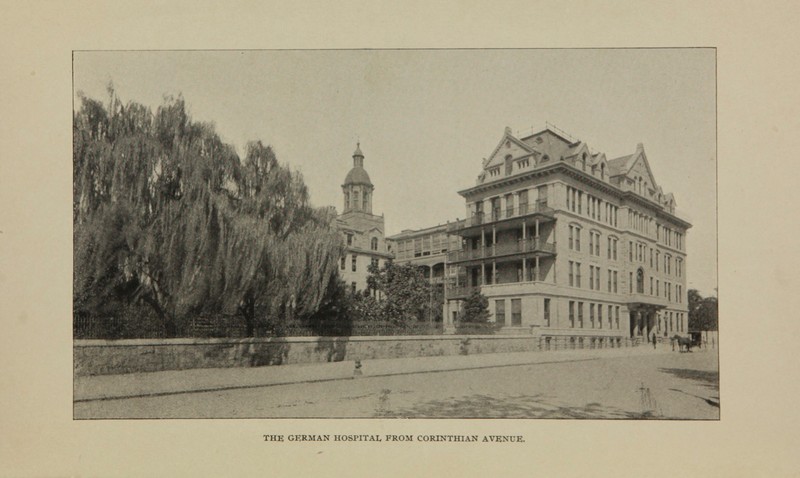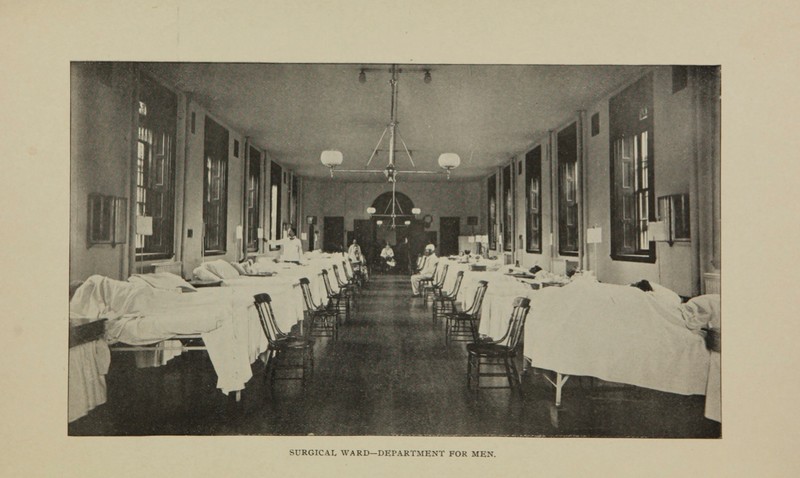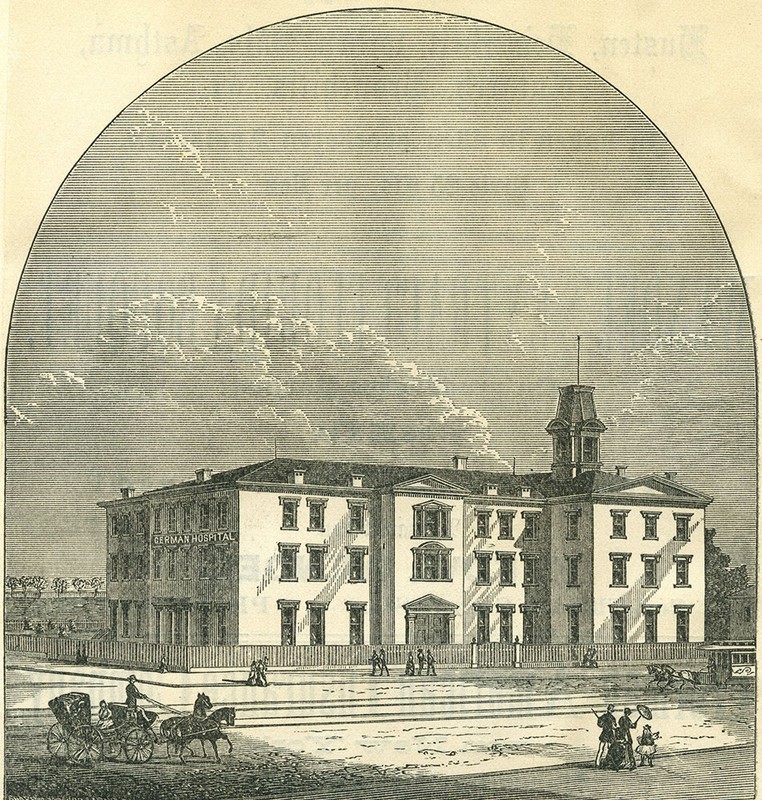German Hospital of Philadelphia (Fairmount 1872-1953)
Introduction
Text-to-speech Audio
The German Hospital of Philadelphia was a medical facility established in 1860 tasked with sheltering and caring for infirmed Germans in Philadelphia. The hospital operated from Philadelphia’s Fairmount neighborhood at Girard and Corinthian Avenues from 1872 to 1911, during a time of great German immigration to the United States. Supported by Philadelphia financiers John D. Lakenau and the Drexel family, the hospital was able to meet the needs of the growing German population. It continues operations today as the Lankenau Medical Center in Lower Merion.
Images
The German Hospital from Girard Avenue (from National Library of Medicine Digital Collections)

The German Hospital from Corinthian Avenue (from National Library of Medicine Digital Collections)

The German Hospital of Philadelphia's surgical ward for men (from National Library of Medicine Digital Collections)

A private room in the German Hospital of Philadelphia (from National Library of Medicine Digital Collections)

Illustration of the German Hospital of Philadelphia (from the Free Library of Philadelphia)

Backstory and Context
Text-to-speech Audio
The German Hospital of Philadelphia was established in 1860 at a former residential building on 20th Street and Norris Street. In a time when Philadelphia—and major American east coast areas—experienced a drastic growth in German immigration, the German Hospital was instituted “to provide a place where the German speaking populace could be treated by persons speaking their own language” (Francis, “Lankenau Hospital”).
Though it was founded in 1860, German Hospital did not begin operations until 1866 due to government occupation of the premises during the United States Civil War. The original facility could house fifty patients. In 1872, the German Hospital relocated southward to a larger area at Girard and Corinthian Avenues in Philadelphia’s Fairmount neighborhood. It gradually acquired more land and became bounded by Girard Avenue and Poplar Street, and Corinthian Avenue, and Twenty-second Street.
Facing rapid population growth in the surrounding neighborhoods and therefore a greater demand for healthcare services, the German Hospital sought a drastic expansion in 1884 to be financed by former trustee and then hospital president John D. Lankenau. Lankenau served as the president of the hospital from 1874 until his death in 1901 and remained a major benefactor throughout this time, along with his wife Mary and brother-in-law Anthony J. Drexel, founder of Drexel University. The expansion added a new “four-story wing,” “new operating amphitheater,” and the Mary J. Drexel Home, which included “accommodations for one hundred sisters, a Children’s Hospital…a school for girls comprising both a day- and a boarding-school, and…a most beautiful Chapel” (Freese, 14; 29). Electricity and lighting was fully added in 1890.
In 1917, the German Hospital was officially renamed Lankenau Hospital after John D. Lankenau. This renaming occurred in the midst of World War I, a time of rising anti-German sentiment in the United States.
In 1953, Lankenau relocated to Lancaster and City Avenues in Lower Merion just outside of Philadelphia after nearly 100 years in the city. The mid-20th century building was designed by the award-winning architect Vincent G. Kling, who also designed Philadelphia’s Love Park, Dilworth Park, Penn Center, and Bell Atlantic Tower.
In 1966, Lankenau began expanding its medical services and education programs in collaboration with Jefferson Medical College. Now referred to as Lankenau Medical Center, it continues to operate as a nationally-recognized medical facility in addition to the Lankenau School of Nursing and Lankenau Institute for Medical Research.
Sources
Francis, Gerald A. “Lankenau Hospital.” The Lower Merion Historical Society. Accessed March 19, 2022. http://lowermerionhistory.org/?page_id=187188.
Freese, Carl. “History of the German Hospital.” Girard Printing House, 1895. Retrieved from National Library of Medicine. Accessed March 19, 2022. http://resource.nlm.nih.gov/68120450R.
Maier, Phyllis C., eds. Jean B. Toll and Michael J. Schwager. “Lower Merion.” The Montgomery County Federation of Historical Societies, 1983. Retrieved from The Lower Merion Historical Society. Accessed March 19, 2022. http://lowermerionhistory.org/?page_id=250.
Mercier, Dominic “In Memoriam: Vicent G. Kling, FAIA.” American Institute of Architects Philadelphia Chapter. Accessed March 19, 2022. https://www.aiaphiladelphia.org/news/memoriam-vincent-g-kling-faia.
Freese, Carl. “History of the German Hospital.” Girard Printing House, 1895. Retrieved from National Library of Medicine Digital Collections. Accessed March 19, 2022. http://resource.nlm.nih.gov/68120450R.
Freese, Carl. “History of the German Hospital.” Girard Printing House, 1895. Retrieved from National Library of Medicine Digital Collections. Accessed March 19, 2022. http://resource.nlm.nih.gov/68120450R.
Freese, Carl. “History of the German Hospital.” Girard Printing House, 1895. Retrieved from National Library of Medicine Digital Collections. Accessed March 19, 2022. http://resource.nlm.nih.gov/68120450R.
Freese, Carl. “History of the German Hospital.” Girard Printing House, 1895. Retrieved from National Library of Medicine Digital Collections. Accessed March 19, 2022. http://resource.nlm.nih.gov/68120450R.
Castner, Samuel. German Hospital. Philadelphia. Scrapbooks. Retrieved from the Free Library of Philadelphia. https://libwww.freelibrary.org/digital/item/44639.
